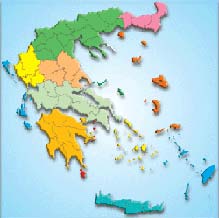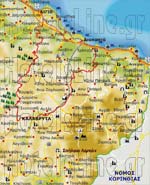
Please click on the map,
the region you want to visit |
|
|
|
|
| |
|
 |
Cave of Lakes in Kastria |
|
 The Cave is located near the village of Kastria, through the limestone mountain of Amolinitsa, the mountain of Chelmos, at an altitude of 850 metres. The Cave is located near the village of Kastria, through the limestone mountain of Amolinitsa, the mountain of Chelmos, at an altitude of 850 metres.
It lies about 17 km from the town of Kalavrita, 9 km from Klitoria and 60 km from Tripoli (tunnel Artemision).
The name derives from the many small lakes formed within and its uniqueness is the result of an extraordinary internal configuration at three different levels, which are not detected in any other cave in the world.
Particular attention is being given to it by the paleontological discoveries that have been found, as fossils of human bones and of animal species including the hippopotamus, which has an international importance.
An underground river is responsible for the creation of this unique cave, its total length that has been explored is 1980 meters of which 500 are accessible, enough for the visitor to admire this exquisite creation of nature.

The interior
There are 13 lakes inside the cave, in three different levels, with water during all the year and several smaller lakes which hold the water in when it is abundant during the winter season.
The supply is from the internal sources and from the rainwater that entering through the cracks of the roof of the cave.
When the water flow is increased, are creating natural waterfalls in different parts of the cave revealing beautiful images. During the summer, the retreat of the water reveals natural stone lakes with lacy formations and natural dams over 4 meters to its level. The reflection of the formations of the roof into the waters of the lakes composes an extraordinary scenery.
The roof which in some places reaches 30 meters in height and the impressive formations of stalagmites and stalactites which are reflected into the waters of the lakes, forming an amazing spectacle, provoking the admiration of visitors.
|
 |
The entry to the cave is an artificial tunnel which leads to the second floor in the "chamber of the bats", and then at the other rooms of the cave (Kastro, Yperoo, Pier of stoned water lilies etc.).
The tour takes place in the specially-designed corridors and bridges with a very good lighting, highlighting the special atmosphere of the area and giving to visitor the opportunity to see and admire the rich natural decor of the cave. |

Opening hours: 09:30 - 16:30
Over the summer and holidays there is a longer period of entry.
Tel 26920.31.001, 26920.31.633
Fax 26920.31.588 |
|
|
|
During the walk you will find unique clusters of stalagmites and of stalactites on the walls and on the ceiling.
Systematic measurements recorded 24 hours a day in the cave, observe a constant temperature throughout the passage of the cave (from 16,1 ° C to 17 ° C). |
 |
Access
The access to the area is easy via the existing road network. Find out the route on the next map (click to see it enlarged) from the National road Athens - Patras, Kalavrita, Kastria.
Accommodation
For your stay in the surrounding area there are few places in the Ano and Kato Loussoi and several more, of different types and categories, in the area of Kalavrita.
|
The exploration
The exploration of the cave began in 1964 by the Greek Mountaineering Association headed by Professor J. Melentis and with the assistant of the residents of Kastrion who went first to the second floor with wooden ladders 9 m in height. Its mapping done by the Greek Speleological Society and the Speleologist Anna Petrohilou.
The utilization of the cave began in 1981 by the National Tourism Organization, then by the former community of Kastrion and continues today by the City of Kleitoria.
The myth
Legend says that the daughters of the king of Tiryns Proetus, Lysippe, Ifinoi and Ifianassa, who bragged that they were more beautiful than the goddess Hera and scorned the gods and the cult of Dionysus. The companion of Zeus Hera did not forgive them their arrogance and stirred their minds, thus making them to believe that they were heifers (cows) and running in meadows and mountains of the Peloponnese, infecting the women of Argolis with infanticide mania. Once they arrived at the cave of the castle, where were found by Melampus who cured them.
|
| Τα
σχέδια είναι από το Περιοδικό Γαιόραμα |
|
Anthropology
From the findings in the cave, it is revealed that man has used it since the Neolithic period and throughout the First and Middle Helladic to Late Helladic period, people who were young persons, children, pre-teens and young adults with biological affinity.
The findings
The excavation of the natural entrance of the cave by Professor J. Melenti in 1965, revealed significant findings with highlights the:
a) Small pieces of the maxillary segments with zygomatic bone and some hare teeth (Lepus timidus Linne) which lived in the Pleistocene era in Greece and in the wider Balkan region.
b) A few bones in a good shape and fully fossils that belongs to the typical representative of Artiodactyla (Hippopotamus antiquus Desmarest Syn. Hippopotamus antiquus major Nesti), which lived in the Peloponnese the Upper Pleistokaino time (300 thousand years ago). Professor J. Melenti explains the presence of Hippopotamus in the cave as a result of the drought environment.
c) The skull, a part of the upper jaw, some vertebrae and other small bones of a wild goat (Capra hireus Linne), all in calcium (were in the first stage of petrification).
d) Findings from a common deer (Cervus elaphus Linne), which lived and still lives today in Greece.
From the findings of animals, it is proved that the cave was occupied 450 thousand years ago until today. The oldest habitant of the cave was the Hippopotamus antiquus, with its bones completely petrified. |
 |
Accommodation proposals, entertainment and shopping in Kalavrita |
|
|
|